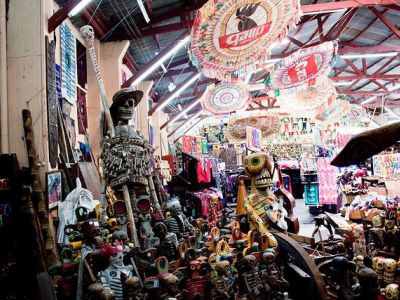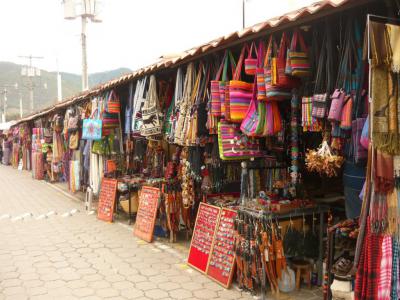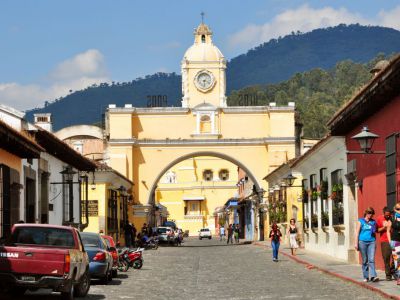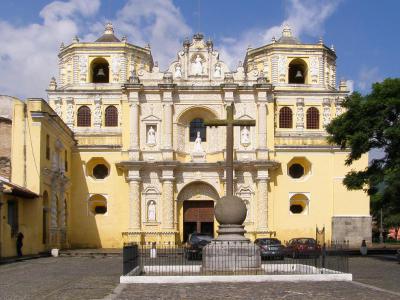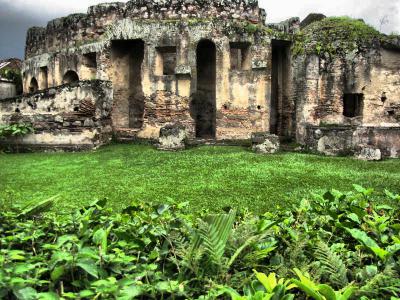Custom Walk in Antigua, Guatemala by michele_perlman_d4223 created on 2025-07-04
Guide Location: Guatemala » Antigua
Guide Type: Custom Walk
# of Sights: 6
Tour Duration: 1 Hour(s)
Travel Distance: 2.1 Km or 1.3 Miles
Share Key: 3GUNC
Guide Type: Custom Walk
# of Sights: 6
Tour Duration: 1 Hour(s)
Travel Distance: 2.1 Km or 1.3 Miles
Share Key: 3GUNC
How It Works
Please retrieve this walk in the GPSmyCity app. Once done, the app will guide you from one tour stop to the next as if you had a personal tour guide. If you created the walk on this website or come to the page via a link, please follow the instructions below to retrieve the walk in the app.
Retrieve This Walk in App
Step 1. Download the app "GPSmyCity: Walks in 1K+ Cities" on Apple App Store or Google Play Store.
Step 2. In the GPSmyCity app, download(or launch) the guide "Antigua Map and Walking Tours".
Step 3. Tap the menu button located at upper right corner of the "Walks" screen and select "Retrieve custom walk". Enter the share key: 3GUNC
1) Craft Market
The Craft Market in Antigua is a vibrant hub of traditional artistry and cultural exchange nestled within the cobblestone streets of this charming colonial city. The market is renowned for its wide array of artisanal crafts, showcasing the rich cultural heritage of Guatemala's indigenous communities. Visitors can explore stalls brimming with handmade textiles, intricate woven fabrics, vibrant clothing, embroidered blouses known as "huipiles," and exquisitely crafted jewelry adorned with traditional motifs and colorful beads.
What sets the Craft Market apart is its emphasis on preserving traditional techniques passed down through generations. Skilled artisans often demonstrate weaving, embroidery, and pottery-making, providing visitors with a fascinating glimpse into the meticulous process behind each artisanal piece.
Beyond textiles and jewelry, the market offers an eclectic mix of goods, including wooden masks, ceramics, leather goods, paintings, and hand-carved items. Each item tells a story, reflecting Guatemala's diverse cultural tapestry and the artisans' dedication to their craft.
The Craft Market serves as a melting pot of cultures, attracting visitors from around the globe who come to appreciate and purchase these unique treasures. It's not uncommon to engage in conversations with artisans about their craft, the significance of certain designs, or even the history of Guatemala itself, fostering meaningful cultural exchanges.
By shopping at the Craft Market, visitors directly support local artisans and their communities, contributing to sustainable livelihoods and the preservation of Guatemala's cultural heritage. Many artisans rely on the market as their primary source of income, making each purchase a meaningful investment in their craft and cultural legacy.
What sets the Craft Market apart is its emphasis on preserving traditional techniques passed down through generations. Skilled artisans often demonstrate weaving, embroidery, and pottery-making, providing visitors with a fascinating glimpse into the meticulous process behind each artisanal piece.
Beyond textiles and jewelry, the market offers an eclectic mix of goods, including wooden masks, ceramics, leather goods, paintings, and hand-carved items. Each item tells a story, reflecting Guatemala's diverse cultural tapestry and the artisans' dedication to their craft.
The Craft Market serves as a melting pot of cultures, attracting visitors from around the globe who come to appreciate and purchase these unique treasures. It's not uncommon to engage in conversations with artisans about their craft, the significance of certain designs, or even the history of Guatemala itself, fostering meaningful cultural exchanges.
By shopping at the Craft Market, visitors directly support local artisans and their communities, contributing to sustainable livelihoods and the preservation of Guatemala's cultural heritage. Many artisans rely on the market as their primary source of income, making each purchase a meaningful investment in their craft and cultural legacy.
2) Antigua's Local Market
Antigua's Local Market, situated on the west side of Antigua, is a vibrant and extensive marketplace, a must-visit for both locals and tourists. This market offers a wide array of goods including traditional Guatemalan blankets, purses, clothing, wallets, scarves, shoes, and souvenirs, housed in hundreds of stalls that create a lively, organized maze.
The main building of the market is divided into two areas: one dedicated to food and the other to miscellaneous items. The food section is bustling on Mondays, Thursdays, and Saturdays-known as "market days"-while the sections for souvenirs and dining are open throughout the week.
The local side of the market is ideal for those in search of authentic crafts, gifts, and accessories, where bargaining is both expected and encouraged to secure the best prices. The market is renowned for its diverse offerings ranging from clothing, such as jeans, to unique handicrafts like textiles and wood-carved figures, as well as a variety of fresh produce, meat, and fish.
The market maintains high standards of cleanliness, with dedicated days for cleaning the food areas. Visitors on Saturdays should be prepared for crowds, keeping an eye on personal belongings while soaking in the colorful and unique atmosphere of Guatemalan life. Antigua's Local Market truly offers an immersive experience into the local culture and commerce, making it an unmissable destination in Antigua Guatemala.
The main building of the market is divided into two areas: one dedicated to food and the other to miscellaneous items. The food section is bustling on Mondays, Thursdays, and Saturdays-known as "market days"-while the sections for souvenirs and dining are open throughout the week.
The local side of the market is ideal for those in search of authentic crafts, gifts, and accessories, where bargaining is both expected and encouraged to secure the best prices. The market is renowned for its diverse offerings ranging from clothing, such as jeans, to unique handicrafts like textiles and wood-carved figures, as well as a variety of fresh produce, meat, and fish.
The market maintains high standards of cleanliness, with dedicated days for cleaning the food areas. Visitors on Saturdays should be prepared for crowds, keeping an eye on personal belongings while soaking in the colorful and unique atmosphere of Guatemalan life. Antigua's Local Market truly offers an immersive experience into the local culture and commerce, making it an unmissable destination in Antigua Guatemala.
3) Santa Catalina Arch (must see)
The Santa Catalina Arch is the most iconic landmark in Antigua Guatemala. Built in 1694 and located on 5th Avenue North, it originally connected the Santa Catalina Convent to a school on the other side of the street. At the time the cloistered nuns lived in the Santa Catalina Convent while they taught at the school during the day.
However there was a dilemma. The cloistered nuns had to avoid all contact with the outside world so they could not simply walk across a busy street to reach the school. To solve the problem, an arch above the street was built to connect the convent and the school. Within the arch there is a hidden passageway enabling the nuns to cross the street without being seen in public. It was an ingenious idea that worked perfectly!
The arch has suffered damage over the years, especially during the catastrophic earthquake of 1773. But miraculously, it has survived and it is now a symbol of the city’s resilience. A clock was added to the top of the arch in the era of the Central American Federation in the 1830s and it needs to be wound every three days.
Today, the Santa Catalina Arch is the most famous city monument and easily the most photographed.
However there was a dilemma. The cloistered nuns had to avoid all contact with the outside world so they could not simply walk across a busy street to reach the school. To solve the problem, an arch above the street was built to connect the convent and the school. Within the arch there is a hidden passageway enabling the nuns to cross the street without being seen in public. It was an ingenious idea that worked perfectly!
The arch has suffered damage over the years, especially during the catastrophic earthquake of 1773. But miraculously, it has survived and it is now a symbol of the city’s resilience. A clock was added to the top of the arch in the era of the Central American Federation in the 1830s and it needs to be wound every three days.
Today, the Santa Catalina Arch is the most famous city monument and easily the most photographed.
4) La Merced Church (must see)
La Merced Church in Antigua stands out for its Baroque-style architecture. The building has a beautiful facade with ornamental elements set in relief and a striking yellow color of the main walls complemented by white plaster sculptures. The church has its origins in a monastery that existed from the 17th century. After an earthquake in 1773, important statuary moved to a new congregation. However, La Merced Church's community moved back to the original building in the mid-19th century.
One of the unique things about the church is the low height of its two bell towers - it is designed to withstand the frequent tremors in Guatemala. San Pedro Nolasco, who founded the Order of the Blessed Virgin Mary of Mercy appears in an effigy form on top of the church building. The crest for his order, as was as images of two friars from this order, appear on either side of San Pedro Nolasco's image.
The facade's central niche contains an image of Our Lady of Mercedes. On the left side of this image, visitors can see effigies of San Pedro Arinengol and San Raymundo Nonnatus. Images that visitors can see on the right include depictions of San Pedro Pascual and Santa Maria de Cervellón.
After more than three centuries, the building is still standing and remains in good shape. Today the church is popular with locals and tourists alike.
One of the unique things about the church is the low height of its two bell towers - it is designed to withstand the frequent tremors in Guatemala. San Pedro Nolasco, who founded the Order of the Blessed Virgin Mary of Mercy appears in an effigy form on top of the church building. The crest for his order, as was as images of two friars from this order, appear on either side of San Pedro Nolasco's image.
The facade's central niche contains an image of Our Lady of Mercedes. On the left side of this image, visitors can see effigies of San Pedro Arinengol and San Raymundo Nonnatus. Images that visitors can see on the right include depictions of San Pedro Pascual and Santa Maria de Cervellón.
After more than three centuries, the building is still standing and remains in good shape. Today the church is popular with locals and tourists alike.
5) Convent of the Capuchins (must see)
One of the finest examples of an 18th-century convent in Guatemala, the Convent of the Capuchins was consecrated in 1736. In fact, it was the last convent to be built in the city, and the first one that stopped asking for a donation to the new nuns, allowing then poor ladies to embrace religious life. Daily routine for the nuns was ruled by strict regulations, which included, for some, maximum discipline on poverty, penance and fasting. Drinking chocolate was strictly forbidden and the requirement that they should survive on the tithing only.
Like the rest of the city, the building complex suffered damage during the 1751 and 1773 earthquakes, and was abandoned by order of the Captain-General at the time. Today, the monastery's well-preserved cells, gardens, and courtyards are open for public viewing and provide excellent photo-ops. Each twist and turn presents a view your camera will ache to capture! It's also interesting to see how small the cloisters were, and how the nuns lived during colonial times.
Tip:
The only guide is the map in the first room, so study it carefully! Don't miss the round room beneath the Nun's tower: sing quietly and be rewarded – the acoustics are incredible. The 2nd-floor art display is new and very nice, as well.
Like the rest of the city, the building complex suffered damage during the 1751 and 1773 earthquakes, and was abandoned by order of the Captain-General at the time. Today, the monastery's well-preserved cells, gardens, and courtyards are open for public viewing and provide excellent photo-ops. Each twist and turn presents a view your camera will ache to capture! It's also interesting to see how small the cloisters were, and how the nuns lived during colonial times.
Tip:
The only guide is the map in the first room, so study it carefully! Don't miss the round room beneath the Nun's tower: sing quietly and be rewarded – the acoustics are incredible. The 2nd-floor art display is new and very nice, as well.
6) San Francsico el Grande (San Francisco Cathedral) (must see)
San Francisco Cathedral (San Francisco el Grande), located in Antigua Guatemala, is a historically and culturally significant church, revered particularly for housing the shrine of Peter of Saint Joseph Betancur (Santo Hermano Pedro). Established following the arrival of Franciscan missionaries from Spain in 1530, the Franciscans were originally assigned 120 villages by civil authorities. The first church built by these missionaries was constructed in the Panchoy Valley in 1541, at the current site of the School of Christ (Escuela de Cristo). After suffering damage in 1565, a new sanctuary was erected two blocks away in 1579, parts of which still stand today and represent some of the oldest architecture in Antigua.
Over the centuries, the church and its cloister were expanded and reinforced, notably surviving the 1691 earthquake. However, it sustained severe damage during the earthquakes of 1717, and 1751, particularly in 1773, after which it was only partially reconstructed. Despite these challenges, elements like its façade, characterized by twisted Salomon columns typical of Spanish-American baroque architecture, remain strikingly similar to that of San José Cathedral. Inside, the church houses sixteen vaulted niches with various saints and friars, including notable figures such as the Virgin Mary and San Antonio de Padua.
The church’s bell and clock towers, remnants of its 17th and 19th-century architecture, stand in ruins today. Despite this, the church’s interior remains adorned with rich altarpieces featuring paintings and sculptures by famous artists of the era. Additionally, San Francisco marks the start of Calle los Pasos (Steps Street), which features the Stations of the Cross, a significant religious path traditionally walked solemnly by the faithful.
San Francisco Cathedral thus serves not only as a place of worship but also as a living museum of Guatemalan history and culture, continuing to attract both the devout and the curious.
Over the centuries, the church and its cloister were expanded and reinforced, notably surviving the 1691 earthquake. However, it sustained severe damage during the earthquakes of 1717, and 1751, particularly in 1773, after which it was only partially reconstructed. Despite these challenges, elements like its façade, characterized by twisted Salomon columns typical of Spanish-American baroque architecture, remain strikingly similar to that of San José Cathedral. Inside, the church houses sixteen vaulted niches with various saints and friars, including notable figures such as the Virgin Mary and San Antonio de Padua.
The church’s bell and clock towers, remnants of its 17th and 19th-century architecture, stand in ruins today. Despite this, the church’s interior remains adorned with rich altarpieces featuring paintings and sculptures by famous artists of the era. Additionally, San Francisco marks the start of Calle los Pasos (Steps Street), which features the Stations of the Cross, a significant religious path traditionally walked solemnly by the faithful.
San Francisco Cathedral thus serves not only as a place of worship but also as a living museum of Guatemalan history and culture, continuing to attract both the devout and the curious.
